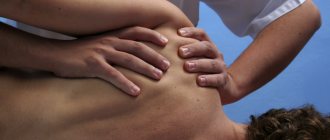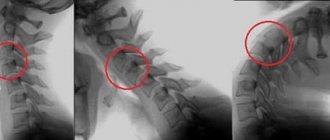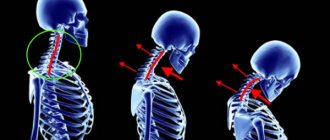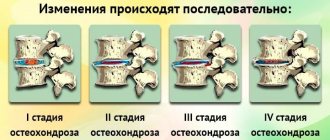From this article you will learn:
- What is manual therapy
- Who is indicated for manual therapy of the cervical spine?
- What are the contraindications for the procedure?
- How is the manual therapy procedure for the cervical spine performed?
- What effect can be achieved
- What are the possible complications?
Osteochondrosis of the cervical spine is a common disease among people who lead a sedentary lifestyle, for example, those who work in an office. Poor nutrition and decreased physical activity are an inevitable consequence of the development of civilization. In this article we will describe one of the most effective ways to combat the manifestations of this disease, which is manual therapy of the cervical spine.
Prices for manual therapy treatment
| SERVICES LIST | PRICE, RUB. |
| Soft manual techniques (45-60 min.) | 7 500 |
| Osteopathic techniques (30-75 min.) | 7 500 |
| Magnetic Vacuum Acupuncture | 1 600 |
| Intra-articular administration of a drug (excluding the cost of the drug) | 4 400 |
| Intra-articular injection (diprospan) | 5 500 |
| Orthoplasma into the joint | 7 000 |
| Intra-Articular PRP Injection | 6 500 |
| PRP therapy for tendonitis, ligamentitis, contractures | 6 500 |
Contact us
Call now
8 (495) 803-27-45
Make an appointment through our service
Make an appointment
Stages of cervical osteochondrosis
Cervical osteochondrosis is characterized by a gradual change in symptoms, which is why the disease is differentiated by specialists into several stages:
- At the first stage, there are practically no symptoms, so the person does not know about the development of pathology. Occasionally, the disease manifests itself as pain in the neck, which intensifies when turning the head.
- The second stage is characterized by increased pain in the cervical region, which spreads to the shoulder or radiates to the arm. Tilts and turns of the neck make the pain syndrome even more pronounced. In the second stage, a person feels limited in mobility, which leads to a reduction in physical activity. Headaches and decreased muscle tone occur.
- The third stage is accompanied by incessant pain, the intensity of which is constantly growing. The development of the disease is characterized by an increase in symptoms of numbness in the hands, muscle weakness, and dizziness.
- At the fourth stage, complete destruction of the intervertebral discs occurs, which leads to constant dizziness and tinnitus. The pain in the neck becomes so intense that taking painkillers has no effect. There is a lack of coordination of movements.
Criteria for choosing a competent specialist
Not every hospital has a chiropractor on staff. Therefore, patients with osteochondrosis often have to look for it on their own. What to pay attention to so as not to make a mistake when choosing a specialist, and not to aggravate the course of the pathology:
- Availability of diplomas and certificates. A chiropractor is a doctor with a higher medical education whose training lasts many years. He constantly practices and improves his skills. Medical school graduates and massage therapists, by definition, cannot be chiropractors;
- medical specialization. Manual therapy is performed only by orthopedists, neurologists, and traumatologists. Doctors of these narrow specializations are well acquainted with the anatomy, structure and functioning of the nervous system;
- gained experience. It is not always right to contact a long-time practitioner. Doctors who have been practicing treatment for a long time are usually graduates of the classical school. They use harsh methods, which leads to pain. Young specialists use a gentle effect on the spine, so during sessions only mild discomfort occurs.
Before treatment, a good doctor will always examine the results of an X-ray, MRI or CT scan. At the same time, he will not refer the patient for additional research. A competent specialist will help you cope not only with osteochondrosis, but also with associated pathologies.
Main causes of the disease
The development of osteochondrosis in the cervical spine occurs as a result of:
- Curvature of the spine, postural disorders.
- Exceeding normal body weight.
- Prolonged stay in static positions (sedentary work).
- Previous injuries to the spinal column.
- Excessive physical activity.
- Genetic predisposition.
- Nervous tension and stress.
- Constant tone of the back muscles (including those due to the specifics of the work).
- Congenital anomalies of the structure of the cervical spine.
Contraindications to the use of this treatment method
Manual therapy of the cervical spine is very effective, but, like any other technique, it has its contraindications:
- Age over 75 years.
- Diagnosed tumor of the brain or spinal cord.
- Tuberculous spondylitis, rheumatism and other inflammatory processes of a nonspecific nature in the spine.
- Meningitis, encephalitis.
- Recovery period after spinal surgery.
- If there are fragments of hernias.
- Presence of acute infection.
- High blood pressure.
- Exacerbation of chronic hepatitis, pancreatitis or cholecystitis.
- Recent heart attack or stroke.
- Vascular diseases.
In addition, contraindications for the use of manual therapy of the cervical spine are relative. The decision is made individually if the patient has:
- Exacerbation of cervical osteochondrosis.
- Instability of some parts of the spine.
- Forstier's syndrome.
- Spinal cleft, sacralization or other anomalies of the spinal column.
- Second or third trimester of pregnancy.
- Fusion fractures of the spine.
A truly professional doctor is attentive to the patient’s medical history and conducts a session only in the absence of absolute contraindications.
Read material on the topic:
Foot massage against fatigue and illness
Symptoms of cervical osteochondrosis
The main symptoms of the disease are expressed:
- Pain (occurs in the cervical region and spreads to the back of the head and shoulders).
- Limited mobility of the neck when bending and turning, a crunching sound appears in the joints of the spine.
- Increasing weakness in the muscles of the arms, decreased sensitivity, tingling and numbness of the palms and fingers.
- Dizziness, lack of coordination when performing movements.
- In the final stages, visual and hearing impairments and numbness of the tongue may occur, which is caused by the development of pathology of the blood supply system in the occipital region.
Manual therapy for the treatment of osteochondrosis
- Myofascial therapy involves working with soft tissues (developing muscles, ligaments, tendons). This method is used to eliminate pathologies of vascular insufficiency and impaired outflow of lymphatic fluid from tissues.
- The cranial method is used in combination with other types of manual therapy and is aimed at improving blood supply to the affected area, reducing spasmodic contractions of the muscles of the neck and back of the head, which helps eliminate headaches and reduce intracranial pressure.
- The arthro-vertebral method is aimed at working out the joints of the cervical spine to restore their mobility. Therapy is carried out using intensive techniques of influencing the structures of the spine, including traction. Massage helps eliminate pain in the neck and back, which is caused by compression of nerve fibers.
Treatment methods
Unprofessional performance of procedures can lead to serious consequences, including injuries to spinal structures, dizziness, and muscle spasms. That is why treatment should only be carried out by a qualified specialist.
Basic techniques used for spinal osteochondrosis:
- Massage. Segmental and relaxation techniques are used to knead muscles, warm up before basic treatment procedures, and relieve tension.
- Mobilization is a set of special movements that are performed by a chiropractor passively or with an emphasis on traction. The method is aimed at restoring the functionality of the affected joints.
- Manipulation. When using this technique, the main impact is carried out by pushes, which are necessary to develop blocked joints. The procedure can often be accompanied by crunching and unpleasant sensations, and allows you to restore the functionality of the joint apparatus. For the same purpose, techniques and techniques such as rhythmic and simple stretching, post-isometric relaxation, and positional mobilization are used.
The main goal of manual therapy procedures is to restore normal mobility to joints and vertebrae, and restore the functionality of the spinal column by working with tissues that have undergone degenerative changes. The most popular is the mobilization technique.
Make an appointment
Treatment of cervical hernia
A hernia in the cervical spine is treated with complex methods, including manual therapy aimed at reducing hypermobility of spinal structures. The process of restoring normal mobility involves the use of automobilization technique, which is performed as follows: the doctor slowly tilts the patient’s head, holding it with one hand and resting the other on the chin. After this, the patient smoothly turns his head to the side, shaking it.
When carrying out the procedure, it is important to perform manipulations strictly in accordance with the rules in order to eliminate the risk of complications:
- Work with the neck is carried out only in the initial stages of osteochondrosis; in the future, the risk of damage to nerve endings and the development of paralysis increases.
- Do not apply sudden pressure or twisting.
- If massage is accompanied by pain, then it is not used.
Manual therapy technique
Manual therapy for cervical osteochondrosis is carried out using several techniques that differ in the intensity of the impact, the direction of action and the effect achieved:
- The pushing technique involves biomechanical irritation of the spinal structures, which is used to reduce the intervertebral disc, subluxate the joint, and destroy benign bone growths (spikes that are the result of ossification of cartilage).
- Rhythmic mobilization techniques include rotation, compression and stretching. This version of manual therapy is painless for the patient, helps restore the correct anatomy of the spinal joints and relieves tension from the muscles of the cervical spine.
- Positional mobilization is a combination technique that uses relaxation techniques, rhythmic mobilization, and manipulation to gently stretch the cervical muscles. Treatment is carried out near the area of the motor segment that has undergone degenerative changes, helping to alleviate the symptoms of radicular syndrome.
The mobilization technique is used to normalize the functionality and mobility of the cervical vertebrae, helping to achieve stable remission in the treatment of chronic osteochondrosis.
Briefly about osteochondrosis.
Many patients answer the question: “What’s bothering you?” they answer briefly: “I have osteochondrosis,” while treating their diagnosis as something ordinary and not serious: it’s the same for everyone. In fact, osteochondrosis is not just a change in bones and cartilage (as it is translated into Russian), it hides a whole set of syndromes, the so-called neurological manifestations of spinal osteochondrosis. And each person may have his own syndrome or even a complex of syndromes. The most common are muscular-tonic syndromes: stiffness in the neck, lower back, between the shoulder blades, in the shoulder girdle, in the buttocks, in the muscles of the thigh and shoulder, in the muscles surrounding the shoulder and hip joints. In addition, manifestations of osteochondrosis are vertebral artery syndrome, radiculopathy of various nerve roots, when the patient is bothered by lumbago and prolonged pain in the form of a stripe (previously it was called radiculitis), headache syndrome (cleverly sounds: cranialgia of vertebral origin), intercostal neuralgia, reflex cardialgia (heart Cardiologists have tested it inside and out: both during exercise and at rest, and with daily monitoring - the heart is healthy, but it still hurts, especially with nervous tension), functional blocks of the vertebrae (in this case, for example, there is a limitation in turning the head to the left or right, body in the lower back to the left or right, or there is an involuntary desire to bend your back back, “so that something clicks there,” or, conversely, bend forward and stretch the longitudinal muscles of the back). Osteochondrosis also includes intervertebral hernia (destruction of intervertebral discs). The elimination of these syndromes is what manual therapy does, except in the situation where the vertebrae are fused and an attempt to separate them will lead to a fracture of the vertebrae.
How are treatment sessions carried out?
Before the start of the treatment session, the chiropractor informs the patient about how the procedure will be carried out and what sensations may be experienced (including painful ones). The patient then sits on the couch, and the doctor performs a manual examination of the spine. To obtain reliable diagnostic results, the patient needs to relax as much as possible and maintain calm, even breathing. When visiting a doctor, it is advisable to bring with you all the available results of previous examinations (X-rays, ultrasound, MRI, reports of general specialists). It will not be difficult for an experienced chiropractor to determine the location of clamps, foci of inflammation, and the condition of spinal segments, muscles and ligaments.
Manual therapy begins with a relaxing massage, the intensity of which gradually increases. The doctor then realigns the vertebrae by pressing and twisting the patient's neck. This stage of treatment may be accompanied by unpleasant sensations and crunching, but this is normal. As a result of treatment, the pain syndrome is eliminated completely or becomes insignificant, the patient feels relief.
The duration of the course of manual therapy and the frequency of treatment sessions are determined by the doctor individually for each patient. The most common rehabilitation treatment regimen involves attending procedures twice a week. In some cases, a daily visit to a chiropractor is allowed if the treatment is easily tolerated by the patient. The effectiveness of the procedures increases if you combine the course with a visit to physiotherapy, acupuncture and other procedures, the indications for which are determined by the doctor. You can also undergo all these procedures in our clinic.
When performing manual therapy procedures, the patient often feels pain, which becomes less pronounced with each new treatment session. This symptom is normal, provided it is short-term and moderate in manifestation, but if the pain syndrome is too strong and difficult to tolerate, you should definitely inform your therapist about it. 1-2 hours after completion of the session, discomfort may be felt, which is associated with the restoration of the normal position of the muscles and ligaments. In cases of severe pain, painkillers may be taken.
Indications for use
Before conducting sessions, the chiropractor studies the results of instrumental diagnostics. X-rays taken in two projections are especially informative. The doctor first gets acquainted with the medical history, listens to the patient’s complaints, and performs an external examination. The following pathological conditions are indications for healing procedures:
- pain in the back of the neck at rest, bending and turning the head, combined with a decrease in range of motion;
- protrusion - protrusion of discs outside the spinal canal, not accompanied by rupture of the fibrous ring;
- various postural disorders that provoke increased pain and limit mobility;
- osteochondrosis of 2 and 3 degrees of severity, the course of which is complicated by deterioration of cerebral circulation.
A chiropractor is often consulted for intervertebral hernias - disc displacement with rupture of the fibrous ring, leakage of the nucleus pulposus. Make an appointment with him for pain that is difficult to eliminate with medication. Such conditions are indications for surgical intervention, but it can often be avoided due to physical impact on the cervical vertebral structures.
Positive effects of manual therapy for osteochondrosis
The indication for the treatment of cervical osteochondrosis using manual therapy methods is the presence of pain, which is caused by degenerative changes in the intervertebral disc and pinched nerve endings. The positive effect is noticeable after the first procedures, and complete relief from unpleasant sensations is achieved in 3-10 sessions, which are carried out at intervals of 2-5 days.
Completion of the course of treatment allows you to eliminate limited movement in the cervical region, relieve tension in the muscles of the neck, occipital region of the head and shoulders, and reduce the intensity of pain when the roots of nerve endings are pinched. About 60% of patients note restoration of hand sensitivity, and neurocirculatory function normalizes.
Completing a full course of treatment with a qualified chiropractor allows you to achieve the following results:
- Restoring the mobility of the joint apparatus.
- Restoration of damaged tissues.
- Eliminate headaches and dizziness.
- The sensation of tinnitus goes away.
- The range of movement of the neck and head increases.
- The pain goes away or is significantly reduced.
- The muscles of the cervical region and upper back are relaxed.
- Numbness of the limbs goes away.
Duration and number of sessions
A good chiropractor will not insist on multiple sessions. Often, 2-3 procedures are sufficient to restore the anatomical position of the discs and vertebrae. Their duration depends on the degree of osteochondrosis, the number of complications that have developed, and the severity of symptoms.
Procedures are not performed more than 3-4 times a week, as the muscles must adapt to the load. At the initial stage of cervical osteochondrosis, treatment rarely lasts more than 3 weeks. And in case of pathology of 3rd degree of severity, manual therapy continues for a month or more.
Prevention of cervical osteochondrosis
To completely eliminate the symptoms of cervical osteochondrosis, the patient is recommended to take comprehensive preventive measures, which include lifestyle changes and the introduction of healthy habits:
- Maintaining a stable weight within normal limits.
- Swimming and exercise classes.
- Alternation of static position and movements in the workplace.
- Changing the working hand when carrying heavy bags.
This ensures an even distribution of the load on the spinal column, eliminating the risk of developing congestion and relapse of negative symptoms of cervical osteochondrosis.
On the day of your initial appointment with any doctor in our Neurology clinic, you can undergo manual therapy or massage with a 25% discount. This way you can form an objective opinion about the services of our clinic and the quality of work of our specialists. And if after this you decide to pay for the full course of further procedures, you will receive a 10% discount on the course of treatment.
A course of manual therapy is carried out in combination with other procedures to enhance the effect of treatment. Depending on the diagnosis, this may be acupuncture, physiotherapy, osteopathy, etc. These procedures complement each other and can be completed in our center.
Who will treat you?
The Innovative Medical Center employs qualified specialists who deal with the treatment of such spinal diseases every day. Numerous reviews on our website and other sources on the Internet confirm the high level of services provided.
Dremin Evgeniy Vitalievich
neurologist, reflexologist, chiropractor.
6 years of experience. More details










